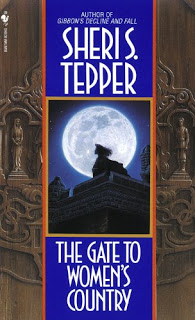

| Online: | |
| Visits: | |
| Stories: |

| Story Views | |
| Now: | |
| Last Hour: | |
| Last 24 Hours: | |
| Total: | |
The Gate to Women’s Country by Sheri S. Tepper
Tuesday, April 11, 2017 2:48
% of readers think this story is Fact. Add your two cents.
The Gate to Women’s Country by Sheri S. Tepper is science fiction story that takes place hundreds of years after the collapse of modern civilization due to a catastrophic event known as “The Convulsion.” The book delves deeply into the issues of gender and violence. As is typical with any fictional exploration on gender, this novel still prompts a lot of Internet discussion despite being first published in 1988.
Tepper has created a fictional society where the genders are separated. In the cities, which are ecologically self – sustaining but relatively low technology, the majority of the population is comprised of women. All the political and social power is, at least on the surface, in control of women. At the age of five boys are sent outside of the city walls. There, an all male, warrior culture exists. At periodic times during the year there is a “Carnival” where the warriors mingle with the women of the city. During this time sexual encounters are frequent. Thus people supposedly procreate.
At the age of fifteen the boys are given a choice: remain outside the city walls, and engage in the occasional brutal wars between the “garrisons” that surround each city, or reenter the city and live their lives as a “servitor”. The servitors live lives of relative comfort and are seemingly well treated, but are second – class citizens. It is a testament to the nuance of Tepper’s skills in crafting this fictional society that the servitors’ relationship to the women of the cities is complex and nuanced. These men are often, but not always, shown respect and are often sometimes treated as equals within family units. It is eventually revealed that some servitors wield power behind scenes and have a great stake in preserving the cities of Women’s Country. It is also revealed that the leadership of Women’s Country are engaged in a selective breeding plan aimed at making future generations of men less prone to violence.
There are other groups that live outside the city walls that follow more egalitarian gender and traditional family roles. Characters who are members of this group provide an important perspective on the cultures of the male garrisons as well as Women’s Country.
The main character in the book is Stavia, a citizen of the city of Marthatown. Stavia is interesting and nuanced. She is a strong and intelligent but also capable of showing weakness. The narrative spans a large percentage of her life from the time she is twelve years old through her late thirties. Other characters include members of Stavia’s family, as well as Joshoa, a servitor who has impressive physical and psychic powers.
Chernon is a young warrior who is Stavia’s love interest. Over time he shows himself to be malevolent and vicious. Like several women in the book, Stavia is attracted to a man despite knowing that such attraction is not in her self – interest. This plot development ties into the novel’s themes.
The story comes to a climax when Stavia and Chernon strike off on a exploration of uncharted lands. They are captured by a group of religious fanatics who treat women as property. This plot development allows Tepper to explore even more angles relating to gender.
The novel has much to say about gender and violence. Throughout the cities of Women’s Country a play called Iphigenia is immensely popular. This work is a modified version of Euripides’s The Trojan Woman. Large parts of the play’s dialogue are included in the text. Iphigenia ties into the novel’s themes in several ways. One of the main messages conveyed in the performance is that violence and war perpetuated by men has devastating consequences for women, children, and for society in general. The play is indictment of violence that is mostly perpetuated by men.
Tepper’s fictional society has found a way to channel violence. The women of the cities, the warriors of the garrisons and the servitors all live by a strict code of laws. The garrisons only war among themselves. Combat is ritualized, takes place as the garrisons face each other in fields, and cannot involve any weapons that have ranges beyond a couple of feet. Only soldiers die or suffer. The remainder of society is not affected in any way. No man is forced to be soldier, as they can choose to be servitors instead.
At one point Stavia’s mother, explains the arrangement to Stavia,
“War is dreadful, daughter. It always has been. Comfort yourself with the knowledge that in preconvulsion times it was worse! More died, and most of them were women, children, and old people. Also, wars were allowed to create devastations. Under our ordinances, no children are slain. No women are slain. Only men who choose to be warriors go to battle. There is no devastation.”
Tepper is pointing out that a percentage of men are violent. She seems to view this kind of men as irredeemable. The men of the garrisons are in the end, all depicted as untrustworthy and prone to dominate and harm others. The breeding program is indication that Tepper believes that a propensity for violence is genetic. Of course the factors that drive violence or complicated, but I agree that there is strong genetic component.
In the book, some men, as represented by the servitors, though capable of violence for self – defense and to protect others, are mostly peaceful, ethical and moral. This also seems to be reflective of the author’s view of men.
In the story it is emphasized that some women, maybe most, are often attracted to destructive and dangerous men. This happens despite the fact that on an intellectual level they know it is not wise to do so. This is a stereotype that we often hear in popular culture. It is common to hear people say that that many women are attracted to dangerous and abusive men. I would like to see data and studies, if this is possible, to determine if there is a propensity for women to do this. My own, extremely biased observations about people, is that a percentage of both woman and men are attracted to destructive people. I have not noticed a difference between genders.
Tepper’s ethical characters end up in terrible dilemma. In order to stop the garrisons from overrunning the cities and enslaving women, from time to time the cities’ leadership, consisting a small number of women and servitors working behind the scenes, manipulate and goad the garrisons into wars that lead to mass slaughters of men. The moral quandary that this raises is expressed at several points in the text.
Tepper offers no easy solution to this dilemma. Though the root of the conundrum is violent men, no one in the know has clean hands.
In some ways this book is a cry of despair in response to human violence. At one point both Stavia and Joshoa are brought to tears over it. Tepper seems to see as the best the solution a matriarchal society that treats non – violent men benevolently. Longer term, in order to eliminate violence in the world, she has created a fantastical breeding program.
My take is that it is easy to become negative about violence in the world. Unimaginable brutality happens. Often non – combatants trapped in proximity to such brutality suffer immeasurably. History and current events show that a small percentage of men are responsible for this violence. Despite these horrors, there are things that reduce violence short of playing with human genetics. I once again I point readers to Steven Pinker’s The Better Angels of Our Nature for practical, evidence based solutions.
I have also recently read Pamela Sargent’s The Shore of Women. My commentary on that book is here. Tepper’s novel was published two years after Sargent’s. There are obvious similarities between the two stories. Both center on matriarchal societies that segregate men and women. Both involve a violent male society living outside the cities. They even both include a plot development that involves the main characters visiting a small misogynist group plagued by inbreeding. One has to wonder if Tepper read the Shore of Women before writing this. However, there are a lot of differences between the works, particularly in the philosophy conveyed. This novel has a lot of unique things to say about gender and violence that are different from Sargent’s views. This book was more intellectual and focused more on themes and symbolism then did Shore of Women. Sargent’s book was more action driven. I like Tepper’s prose better then Sargent’s. Sargent’s prose is flatter.
If I am reading Tepper correctly, I think she is actually advocating for a matriarchal system in order to stem violence. In contrast, Sargent’s philosophy seems egalitarian and advocates for equality.
This book has some flaws. The male characters fit too neatly into categories. The men who choose to stay in the garrisons are depicted as hopelessly violent and untrustworthy. In contrast the servitors are portrayed as almost saint – like. As stated above, this book is also a little too derivative of Pamela Sargent’s novel.
Despite its flaws this work is a fascinating foray into the issues of gender and violence. As I noted in regards to Sargent’s book, one does not need to agree with all or most of Tepper’s philosophy and world – view in order to enjoy these ruminations. Stavia is also a very interesting, nuanced character. The world that Tepper has created here is also fascinating and well thought out.
I would recommend this book to anyone interested in fanciful explorations of gender or violence. It makes an interesting comparison to Sargent’s work. It also will appeal to readers who are interested in fictional societies and cultures. Certain readers will find this book very enjoyable and very thought provoking.
This is a blog about good books. It is a place for me to share my musings about literature, history, culture and science. Most of what one will find here are not plain reviews. Instead, when I discuss a book I tend to explore a thought or two that I have about the work. This is a place for the enthusiastic reader who is curious about the world!
Source: http://briansbabblingbooks.blogspot.com/2017/04/the-gate-to-womens-country-by-sheri-s.html



